Introduction
The AWS Migration Acceleration Program (MAP) has emerged as a vital framework for organizations seeking to transition seamlessly to the cloud. With its structured approach, MAP not only facilitates significant cost savings but also accelerates the rollout of new applications, ultimately enhancing operational efficiency. In a landscape increasingly characterized by digital transformation, the program emphasizes the sharing of expertise and best practices, ensuring that businesses are well-equipped to navigate their unique challenges.
As regulatory requirements evolve and the demand for digital sovereignty intensifies, particularly in Europe, organizations are finding that leveraging AWS's local infrastructure and support can provide a competitive edge. This article delves into the multifaceted benefits of AWS MAP, outlines its operational phases, and explores the essential practices that underpin successful cloud migration. By examining real-world case studies, the discussion underscores the transformative potential of cloud technologies when guided by a strategic approach.
Benefits of Using AWS MAP
The AWS Migration Acceleration Program (MAP) acts as an all-encompassing structure intended to simplify the transition to the cloud for enterprises, effectively placing them for swift expansion and creativity. By leveraging MAP, businesses can benefit from significant cost reductions associated with migration, a faster rollout of new applications, and improved operational efficiency.
A pivotal aspect of AWS MAP is its emphasis on expertise sharing, enabling entities to tap into AWS's wealth of knowledge, funding support, and established best practices. This approach is not only timely but essential, especially as companies navigate the complexities of digital transformation. For instance, entities that utilize this structured methodology report enhanced agility and a more robust alignment with their strategic goals.
Recent insights highlight the increasing trend of digital sovereignty in online service adoption, particularly within the European landscape. AWS has recognized the necessity for local data infrastructure, as highlighted by officials like Stefan Schnorr from the German Federal Ministry for Digital and Transport, who emphasizes the importance of a sovereign digital infrastructure to maintain competitiveness. This coincides with AWS's effort to create autonomous European digital services, providing entities with enhanced options in their digital sovereignty approaches.
Furthermore, companies like GoDaddy exemplify the advantages of a data-driven approach facilitated by AWS. With a focus on efficiency, GoDaddy has optimized its operations through advanced technologies, reflecting the transformative potential that AWS MAP offers. By adopting online solutions, companies can not only improve their operational capabilities but also establish themselves as leaders within their respective sectors.
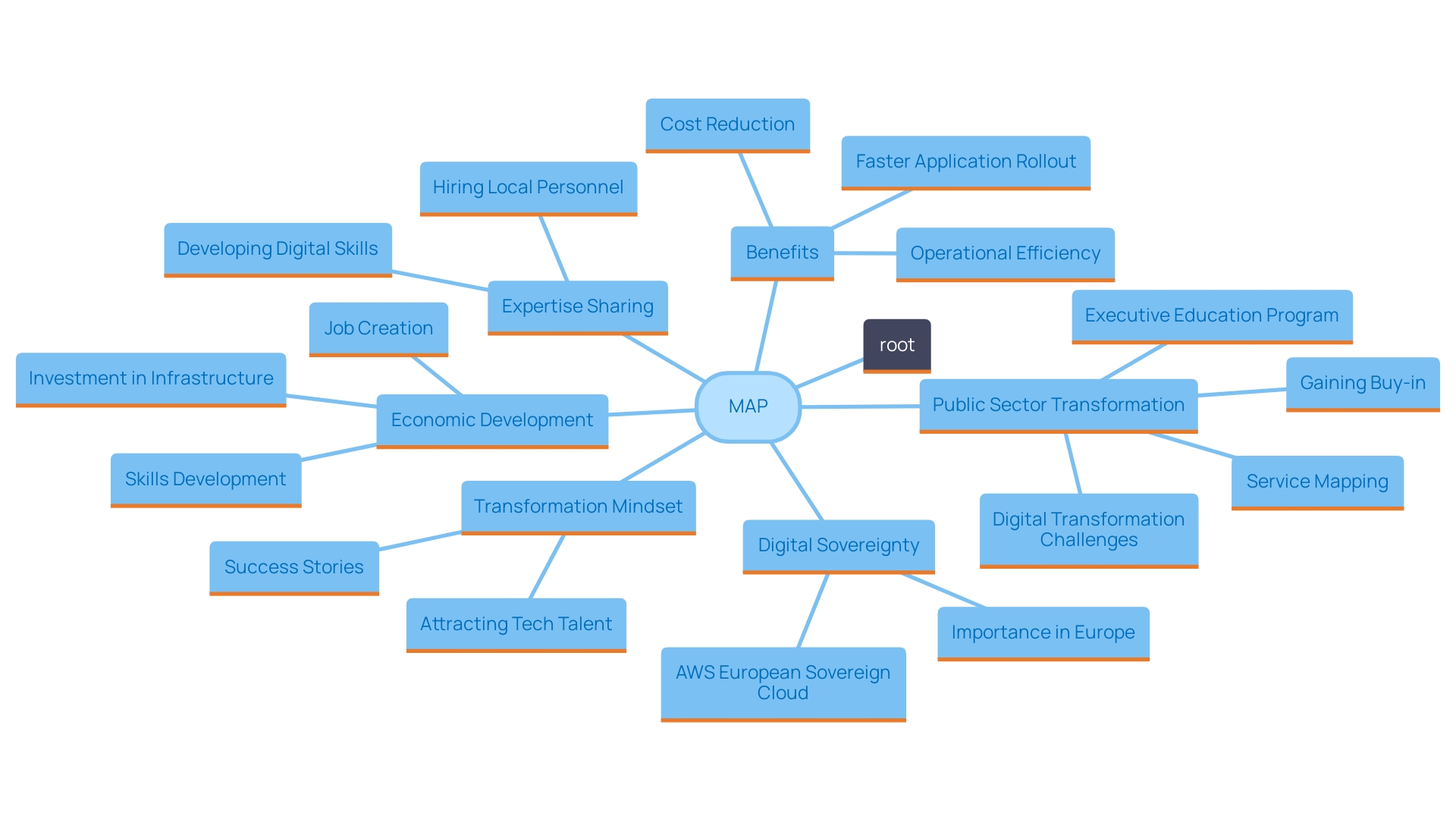
How AWS MAP Works
The AWS Migration Acceleration Program (MAP) is designed to assist entities through a thorough three-phase framework: Assess, Mobilize, and Migrate.
In the Assess phase, entities thoroughly evaluate their current technology environment and preparedness for moving to the cloud. This phase highlights the importance of understanding not just the technical aspects but also the organizational mindset required for successful transformation. As noted in global success stories from places like Singapore, the UK, and Israel, transformation is as much about cultural change as it is about technology.
Moving into the Mobilize phase, the focus shifts to preparing the necessary resources and developing a detailed transition strategy. This includes creating a roadmap that addresses the unique needs of the organization and aligns with its business objectives. Notably, the UK government’s Exemplar program serves as an inspiring example, having successfully transformed 20 services in under two years by adopting a structured and collaborative approach.
Finally, the Migrate phase involves executing the transfer itself. This phase not only involves the technical transfer of workloads but also updating applications to enhance performance in the online environment. Key considerations in this phase involve security protocols and ensuring that the migration meets current standards, as emphasized by experts within the AWS Government Transformation team (GTT).
Furthermore, GTT highlights the necessity of collaboration across various stakeholders during this phase. They underscore the importance of a dynamic planning approach that blends automation with manual processes while prioritizing applications based on business needs, such as processing times and sensitivity levels.
With 93% of IT leaders having participated in repatriation projects in the past three years, it is evident that organizations must continually reassess their strategies to maximize effectiveness and return on investment. Comprehending these stages and applying optimal methods can be crucial in managing the intricacies of digital transformation.
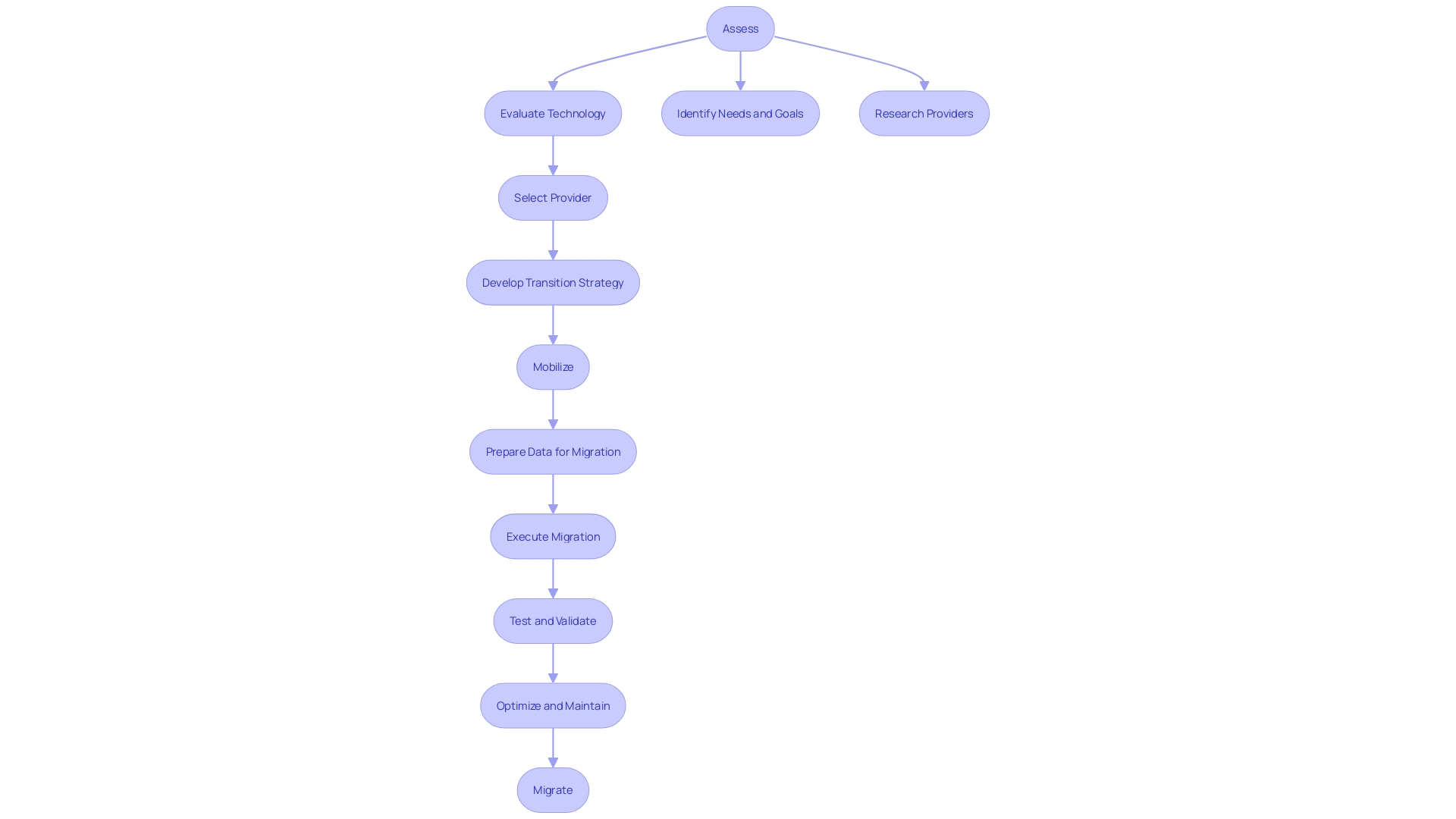
Step 1: Assess Your Readiness
A thorough evaluation of your current IT framework and tasks is essential for a successful transition to online services. Begin by evaluating your current technology stack, application characteristics, and architectural frameworks. 'This examination will help identify which applications are appropriate for transfer, while also uncovering their interdependencies.'.
Utilizing AWS tools and frameworks can significantly enhance this assessment process. Concentrate on essential elements such as performance metrics, security protocols, and compliance requirements to assess readiness for the system. Significantly, transitioning can be complex, especially for applications constructed on distinct hardware that may not be easily virtualized, such as certain IoT applications or cryptocurrency cold wallets.
As Lynn Greiner emphasizes, "Cloud computing today seems to be the future for most applications. Nevertheless, the cloud isn’t a one-size-fits-all solution." Every entity has a unique framework that accommodates its operational requirements, making it essential to thoroughly check application preparedness prior to starting the transfer process.
This initial assessment not only informs your migration strategy but also assists in prioritizing workloads effectively. As emphasized in numerous success narratives, the route to digital transformation often necessitates changes across technology, processes, and individuals within the entity. By ensuring thorough evaluation and planning, organizations can better align their technological capabilities with their strategic goals for integration.
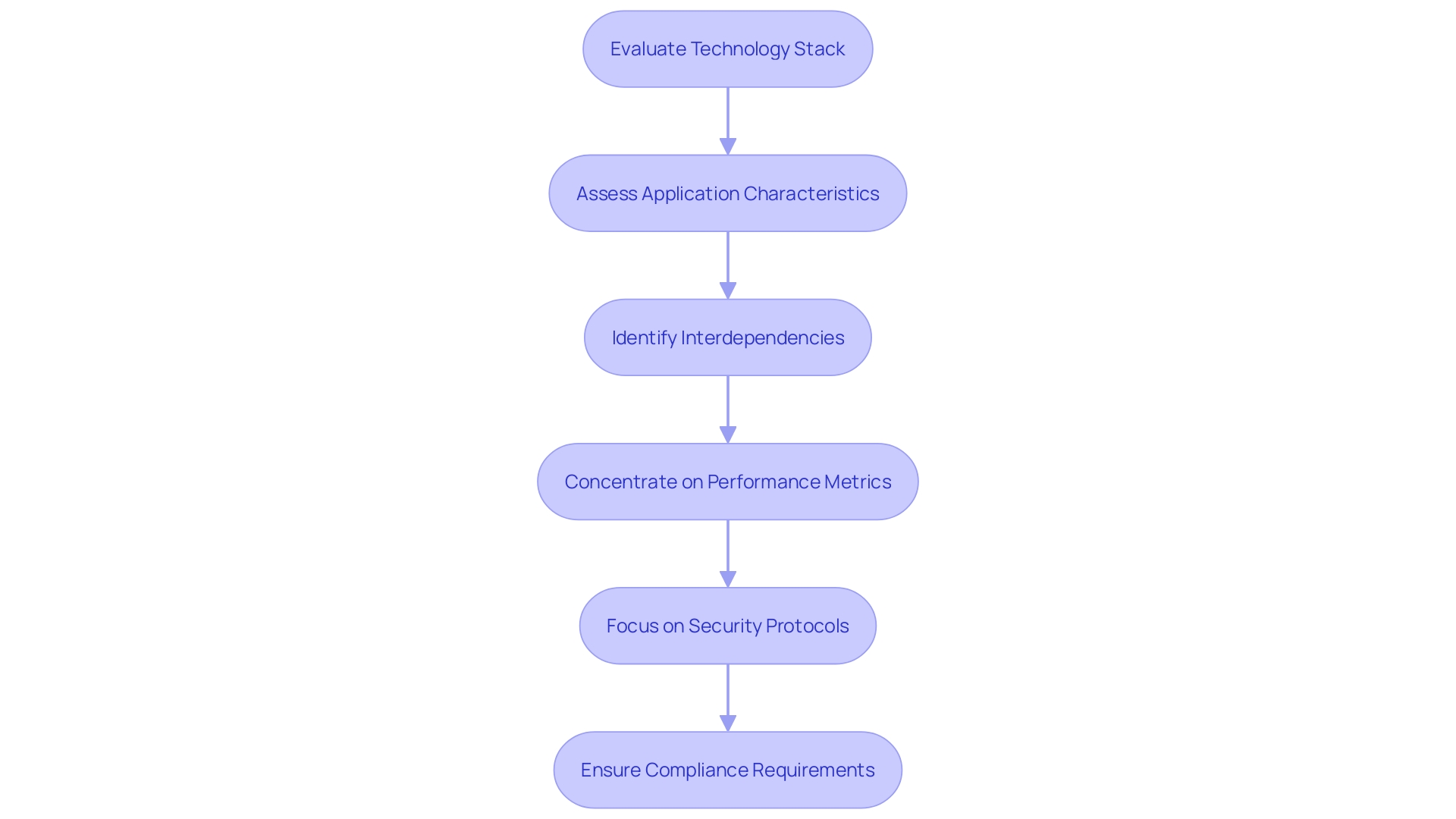
Step 2: Mobilize Your Resources
Resource allocation is a crucial step in the cloud transition process. It involves assembling a cross-functional team that includes members from IT, operations, and various business units. This diverse group is essential for addressing the multifaceted challenges of movement. A comprehensive relocation strategy must be developed, detailing timelines, responsibilities, and key milestones. Doing so ensures that everyone involved understands their role and the expectations placed upon them.
Obtaining the essential financing and assistance from AWS is also crucial for a smooth transition. Organizations should look for providers that demonstrate a proven track record of success, robust security measures, and a wide range of services tailored to their specific needs. As Lynn Greiner, a tech interpreter for businesses, emphasizes, understanding the intricacies of digital migration is key to reducing IT costs, enhancing business agility, and improving overall security.
For instance, companies like Chess.com have modified their infrastructures for online use, which has allowed them to serve over 150 million users effectively. Their Head of Infrastructure, James Kelty, underscores the importance of a stable IT framework that integrates public cloud solutions with on-premises resources to meet user demands worldwide. Executing a comprehensive transition strategy, as demonstrated in Chess.com's method, can greatly ease the difficulties linked to expanding and sustaining a dependable digital platform.
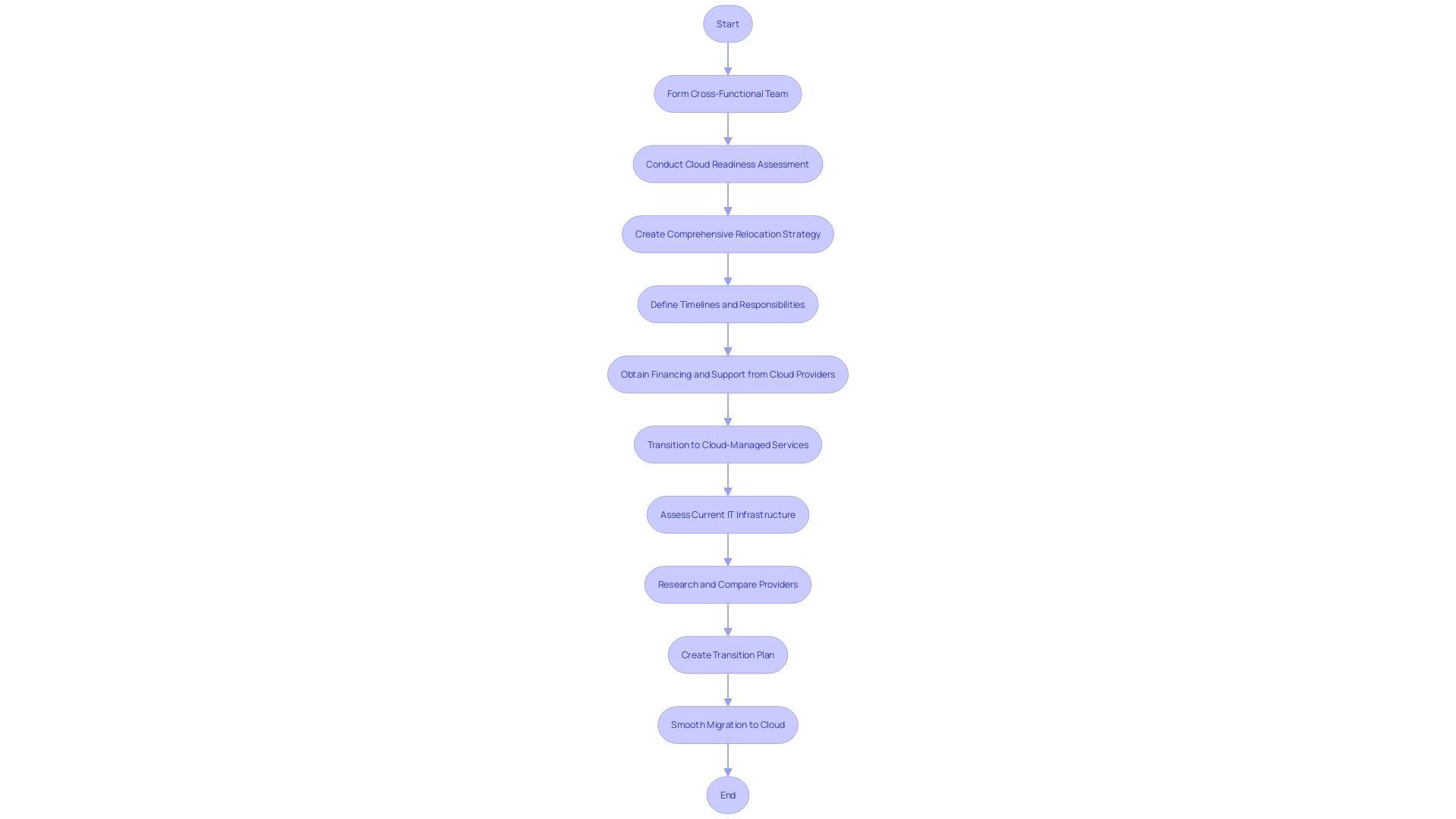
Step 3: Migrate and Modernize Your Workloads
'Implementing a transition plan to move workloads to AWS involves a strategic approach that leverages powerful AWS services, such as the AWS Database Transfer Service and AWS Server Transition Service.'. These tools facilitate a seamless transition, minimizing downtime and ensuring data integrity. As organizations embark on this journey, it is vital to conduct a thorough Cloud Readiness Assessment to evaluate the current technology stack, application characteristics, architecture, and data dependencies.
The AWS Cloud Adoption Framework plays a crucial role in this process. It highlights the significance of recognizing essential stakeholders, such as project managers and team members, who will play a crucial role in steering the transition. Interacting with various departments to talk about application usage, challenges, and required features is crucial for customizing the transition strategy. Furthermore, tackling regulatory requirements and security considerations will aid in reducing risks linked to the transition.
Post-migration, organizations should focus on modernizing their applications to fully leverage cloud-native features. This modernization not only enhances performance but also improves scalability and cost-efficiency. By transitioning to cloud-based architectures, businesses can create highly scalable and elastic workloads, utilizing the latest hardware while benefiting from a pay-as-you-go pricing model.
Ultimately, the transfer process requires a comprehensive understanding of existing technology and operational needs. As noted, while online computing offers substantial benefits, it is not a one-size-fits-all solution. Organizations must carefully evaluate their unique infrastructures and workloads to ensure a successful transition.
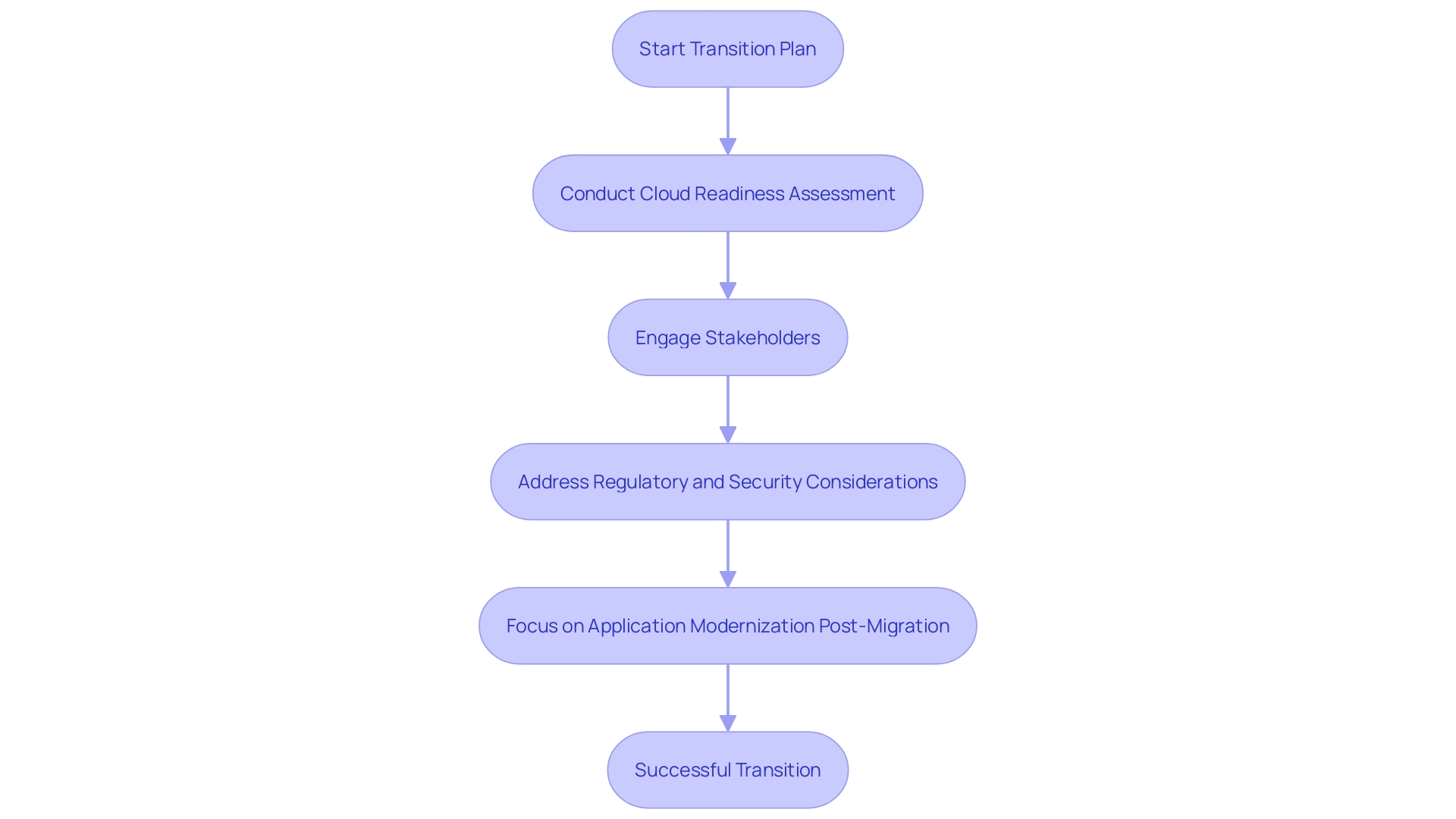
Financial Incentives and Funding
AWS Migration Acceleration Program (MAP) provides an extensive array of funding alternatives aimed at supporting and enhancing your entity's transition to the cloud. These financial incentives can be pivotal in covering various aspects of the relocation journey, including the costs associated with assessments, access to relocation tools, and specialized training resources. Interacting with AWS representatives can reveal a variety of customized funding options that correspond with your entity's specific needs and goals.
The AWS Cloud Adoption Framework is essential in guiding entities through their transition process. It highlights the significance of cooperation among stakeholders, ensuring that all perspectives are considered in the development of a strong relocation strategy. Crucial steps include identifying key stakeholders, fostering open discussions about application usage and pain points, and establishing a clear understanding of regulatory requirements and security considerations.
Real-world examples illustrate the transformative impact of AWS MAP. For instance, significant strides have been made in the public sector, where entities have successfully implemented digital transformation strategies by leveraging AWS resources. The UK government's Exemplar program stands out, having transformed 20 services in under two years, showcasing the potential for rapid and effective change.
Moreover, the growing complexity of data management in sectors such as pharmaceuticals further underscores the relevance of AWS MAP. Organizations are increasingly turning to machine learning techniques to enhance data analysis, improving their ability to derive insights from large datasets. This not only accelerates innovation but also strengthens operational efficiency.
Ultimately, AWS MAP serves as a crucial catalyst for organizations looking to begin their journey to the digital infrastructure, enabling them to harness the full power of online technologies and advance their missions.
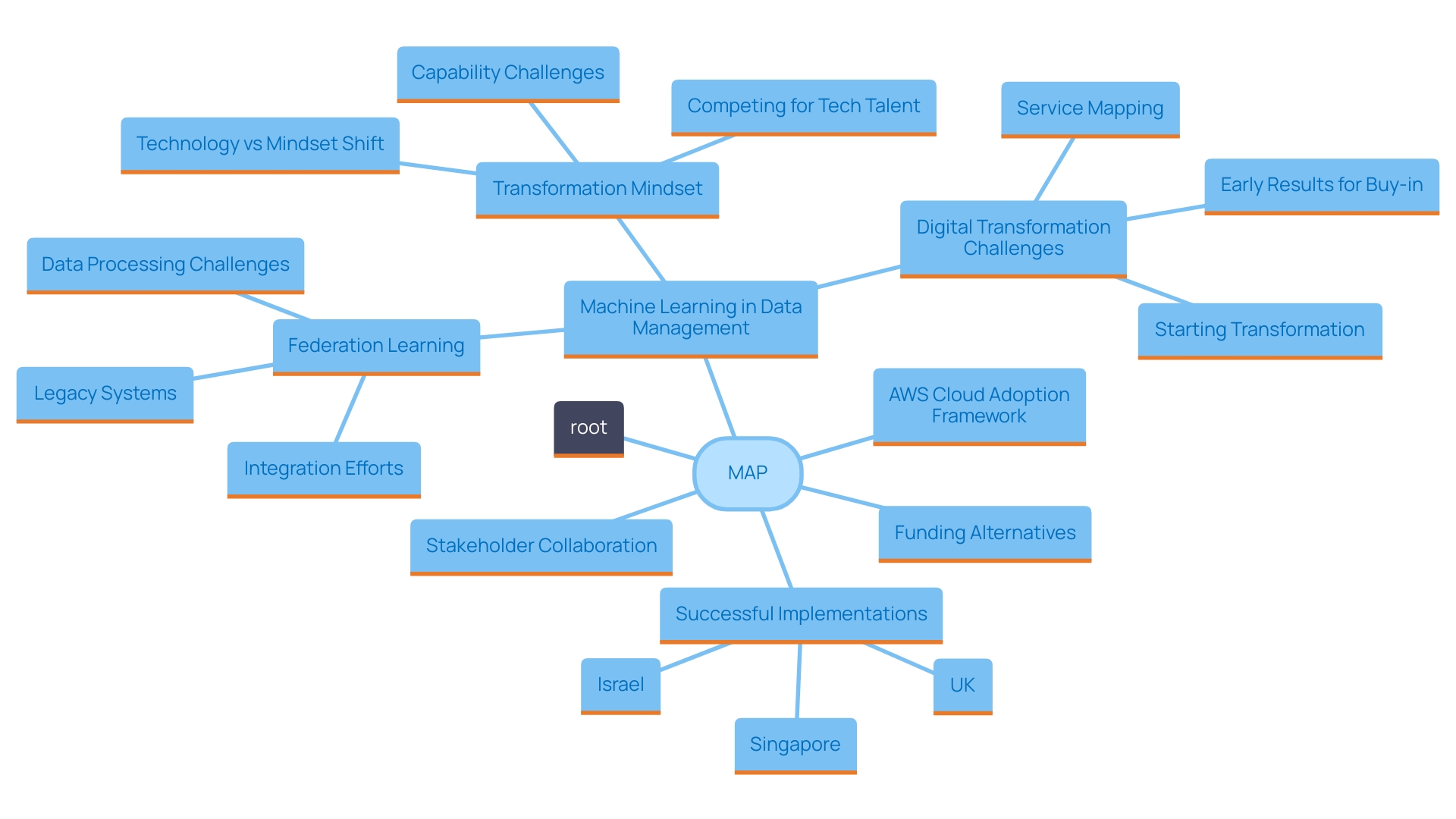
Eligibility Criteria for MAP Funding
Organizations seeking AWS Acceleration Program (MAP) funding must adhere to specific eligibility criteria that showcase their commitment to transitioning to remote infrastructure. Key requirements include:
- Demonstrating a Commitment: Organizations must illustrate a strong intent to migrate workloads to AWS, indicating a long-term vision for leveraging cloud technologies.
- Clear Transition Strategy: A well-defined transition strategy is crucial. This strategy should include the architectural adjustments required for moving to AWS, ensuring that the transition aligns with the entity's overall business goals.
- Engagement with AWS Partners: Working with AWS partners or advisors can greatly improve a company's preparedness for transition. These partnerships provide access to expertise, best practices, and resources that facilitate a smoother transition.
Meeting these standards not only enhances the chances of obtaining financial support but also enables organizations to optimize the advantages gained from their shift to digital infrastructure. For example, organizations such as Dunelm Group plc have effectively utilized transitioning to online services to improve operational efficiency, demonstrating the potential influence of a strategic method to adopting these technologies.
As articulated in industry insights, transformation in technology is not merely about adopting new tools but also requires a fundamental mindset shift. Successful transition narratives, such as those recorded in the AWS Government Transformation team’s initiatives, emphasize the importance of a strong vision and effective execution strategies. These narratives serve as powerful motivators for organizations aiming to embark on their cloud journey.
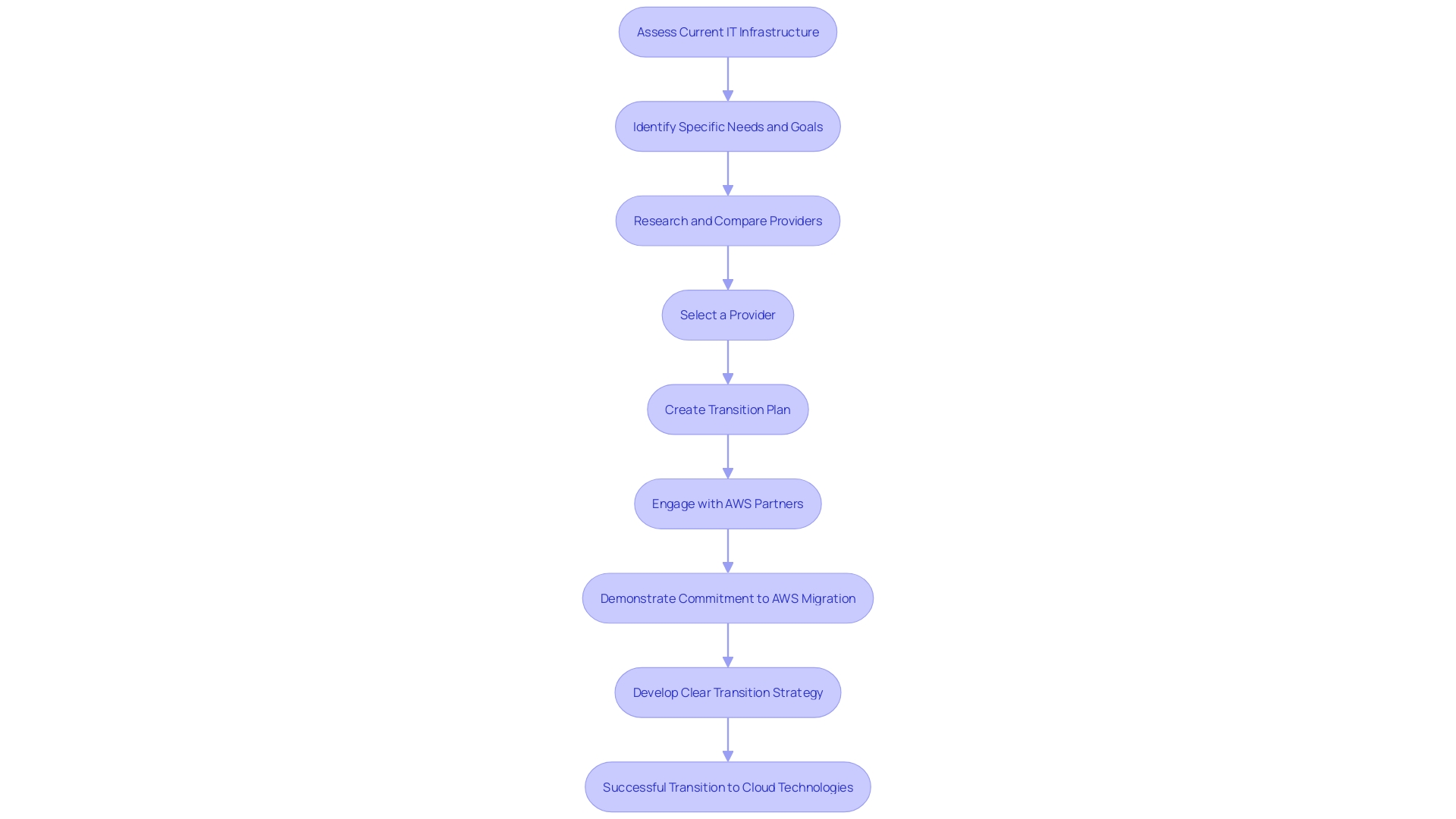
Role of AWS Partners in MAP
"AWS partners are essential to the success of the Migration Acceleration Program (MAP), providing specialized expertise and vital resources throughout the transition journey.". 'Their involvement spans multiple stages, from initial assessments and transition planning to the actual execution of transition strategies.'. By employing best practices and established methods, these partners assist businesses in managing the challenges of cloud transition efficiently.
Collaborating with certified AWS partners can significantly enhance the chances of successful migration. For instance, entities can leverage the insights from the Amazon Web Services (AWS) Government Transformation team (GTT), which collaborates with leading business schools to provide executive education programs. These programs have educated over 5,000 senior public sector officials across 23 countries, offering them a comprehensive understanding of the challenges and opportunities presented by cloud adoption.
Moreover, as highlighted by various success stories from regions like Singapore, the UK, and Israel, transformation is not just a technological shift but also requires a fundamental change in mindset. The UK government's Exemplar program serves as a case in point, successfully transforming 20 services in under two years. This showcases the potential of effective partnerships in achieving rapid and impactful results.
In a landscape where attracting and retaining tech talent is increasingly challenging, AWS partners offer entities with strategic insights that can assist them in developing capabilities and promoting innovation. By utilizing this resource of knowledge, entities can not only improve their transition success but also establish themselves as leaders in digital transformation.
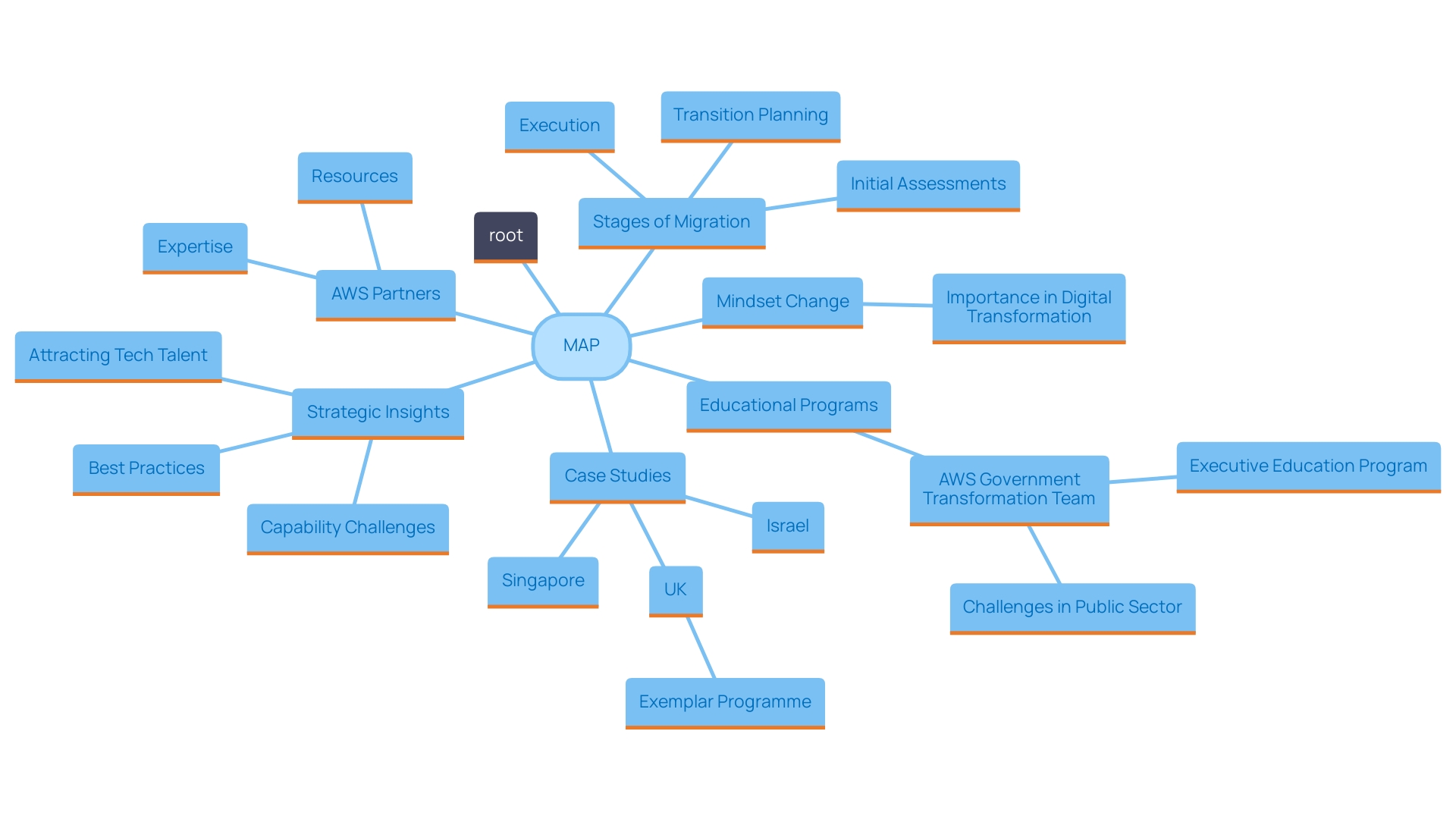
Streamlined Funding and Approval Process
The AWS Migration Acceleration Program (MAP) simplifies the funding approval process to improve efficiency and assist entities in their transition journeys. By utilizing the AWS Management Console, entities can present comprehensive funding proposals that describe their relocation strategies and related costs. AWS is committed to a swift review process, which frequently results in expedited approvals, thereby ensuring that projects remain on schedule.
'This method not only enables technological change but also encourages a crucial shift in perspective, as companies learn to perceive transitioning to digital resources as an essential element of their overall digital strategy.'. For instance, the UK government's Exemplar program serves as a powerful example, having successfully transformed 20 services in less than two years.
Moreover, AWS recognizes that attracting top tech talent is crucial for successful migrations. As competition for skilled professionals intensifies, particularly in the public sector, AWS MAP provides guidance on best practices for talent acquisition and retention, drawing from global insights and success stories. The program also benefits from the expertise of the Government Transformation Team (GTT), which includes former chief technologists and transformation directors who have led extensive reforms across nations. Their combined experiences influence the resources accessible to organizations maneuvering through the intricacies of adopting online services.
'Recent developments, such as the European Data Act set to take full effect in September 2025, also emphasize the importance of a supportive regulatory landscape for online services.'. The act aims to improve conditions for moving data and applications seamlessly between providers, reinforcing AWS's commitment to facilitating efficient migration processes. 'This seamless transfer capability is further enhanced by new contractual obligations for service providers, ensuring that entities can migrate without incurring additional costs.'.
In summary, the AWS MAP not only offers a clear route for funding approval but also aligns with broader trends in government transformation and the changing environment of digital services, making it an essential resource for organizations aiming to innovate and succeed in a digital-first world.
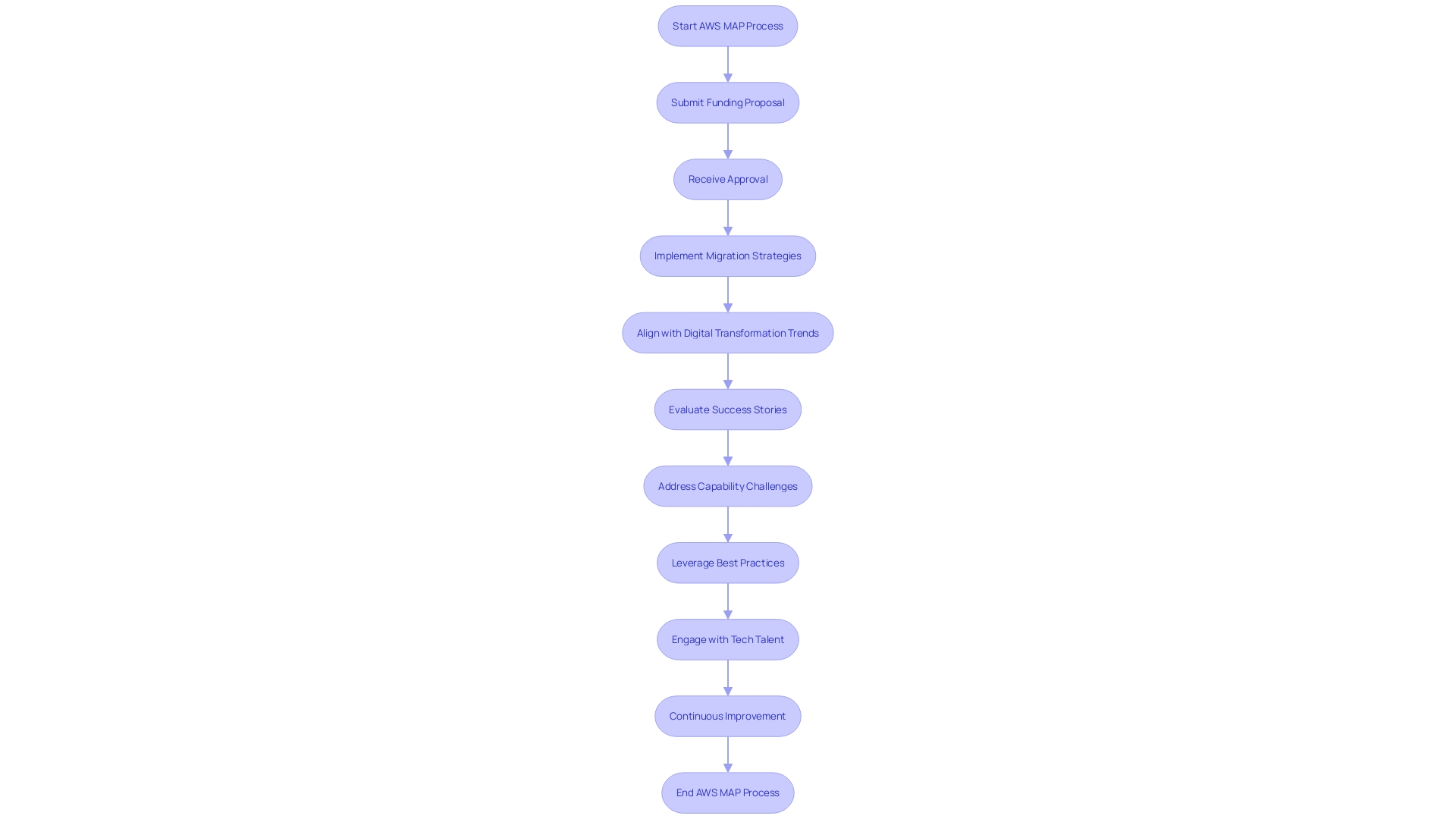
Best Practices for Successful Migration
Achieving success in moving to cloud environments requires following a set of best practices that guarantee a smooth transition. Establishing clear objectives is essential, as these define the end goals and benchmarks for success. 'Open communication among teams fosters collaboration, which is critical for addressing challenges in real-time and aligning various stakeholders with the transition strategy.'.
Regular progress reviews not only help track advancements but also facilitate timely adjustments to the plan. This iterative method enables the recognition of possible obstacles at an early stage, ensuring that the transition remains on track.
Implementing a robust change management strategy is paramount, particularly in addressing the cultural shifts that accompany technological transitions. Organizations must prioritize preparing all stakeholders for the impending changes, which include alterations to workflows and the introduction of new technologies. For instance, as highlighted by Arvind Vaishnav from Philips Innovation Campus, it is vital to rethink how technology interacts with healthcare professionals to enhance their primary focus on patient care.
Moreover, a multiprovider and multipartner strategy can significantly enhance the transition process. Collaboration beyond organizational boundaries, as evidenced by the experience of Guthrie Clinic, underscores the importance of bringing partners together early to enhance security and streamline operations. This holistic approach ensures that both technological and human factors are considered, aligning IT solutions with the unique requirements of the entity.
The creation of a detailed playbook for data collection and information sharing can democratize knowledge across teams, making it easier to prioritize applications based on business needs. For instance, organizations ought to evaluate their existing technology stack and application traits to determine which systems might present difficulties during transition. Recognizing that some applications may be built on unique hardware that cannot be virtualized is crucial for effective planning.
Ultimately, navigating the complexities of transitioning to the cloud requires a comprehensive understanding of technology, processes, and people. A successful transition not only involves the right technical solutions but also a well-prepared workforce that is ready to embrace change.
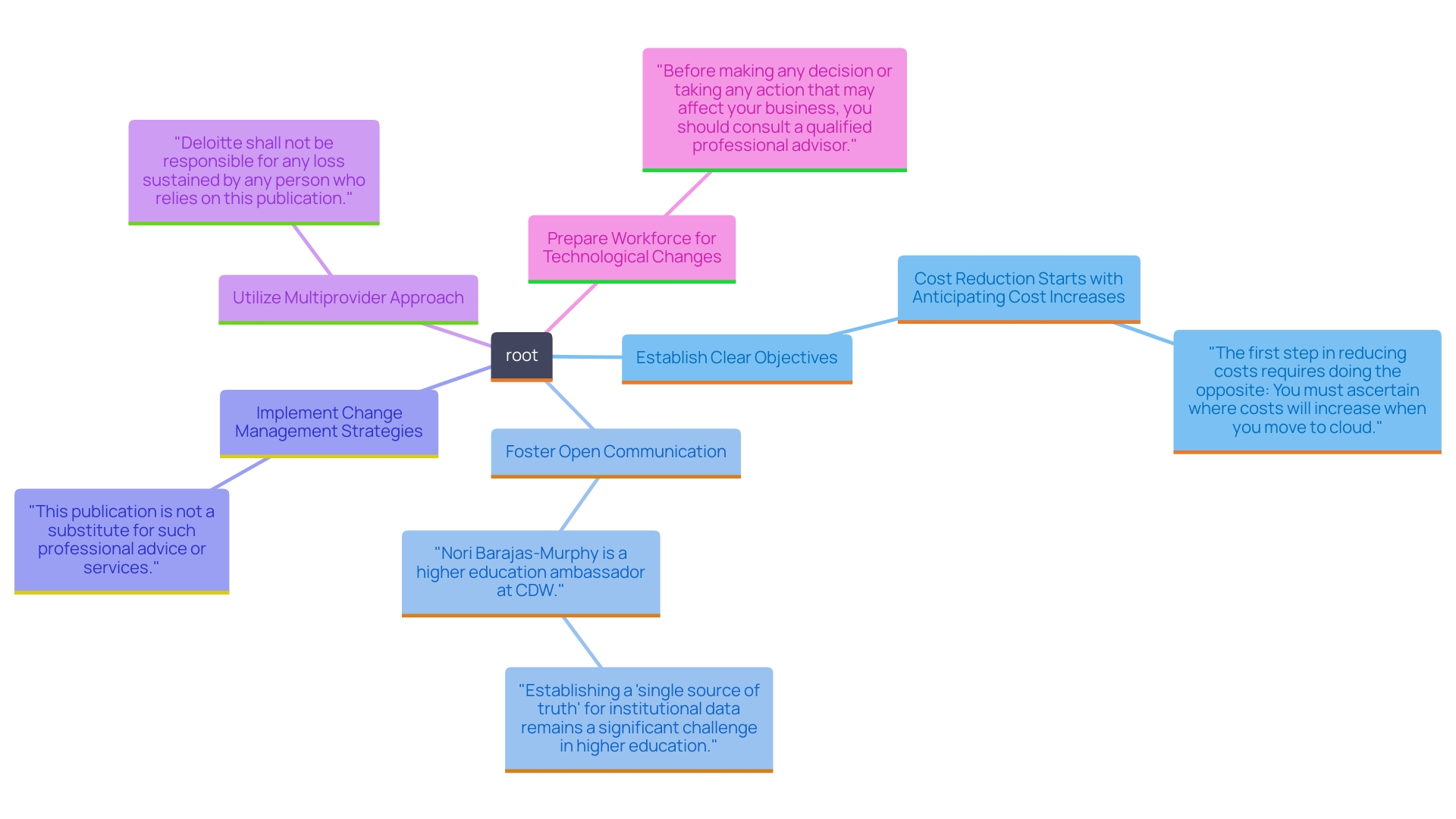
Case Studies and Success Stories
Organizations across various sectors have successfully utilized the AWS Acceleration Program (MAP) to enhance their relocation efforts. These case studies reveal how businesses have achieved substantial cost reductions, increased operational agility, and improved customer experiences through their transition to AWS. For example, the UK government's Exemplar program transformed 20 public services in under two years, demonstrating that successful change is not merely a technological upgrade but also requires a significant mindset shift.
Furthermore, the AWS Government Transformation team (GTT), composed of former senior technologists and transformation directors, has educated over 5,000 public sector leaders across 23 countries. Their feedback has illuminated common challenges in digital transformation, thereby guiding future initiatives. In this context, the GTT emphasizes the importance of having a strong vision to unlock effective transformation, alongside practical approaches to service mapping that yield early results.
Along with these insights, entities can investigate different approaches to draw in and keep leading tech talent, particularly in the public sector, where rivalry is intense. By leveraging global best practices, businesses can implement successful transitions that serve as benchmarks for others. Analyzing these success stories not only fosters inspiration but also equips organizations with actionable insights to navigate their unique migration journeys.
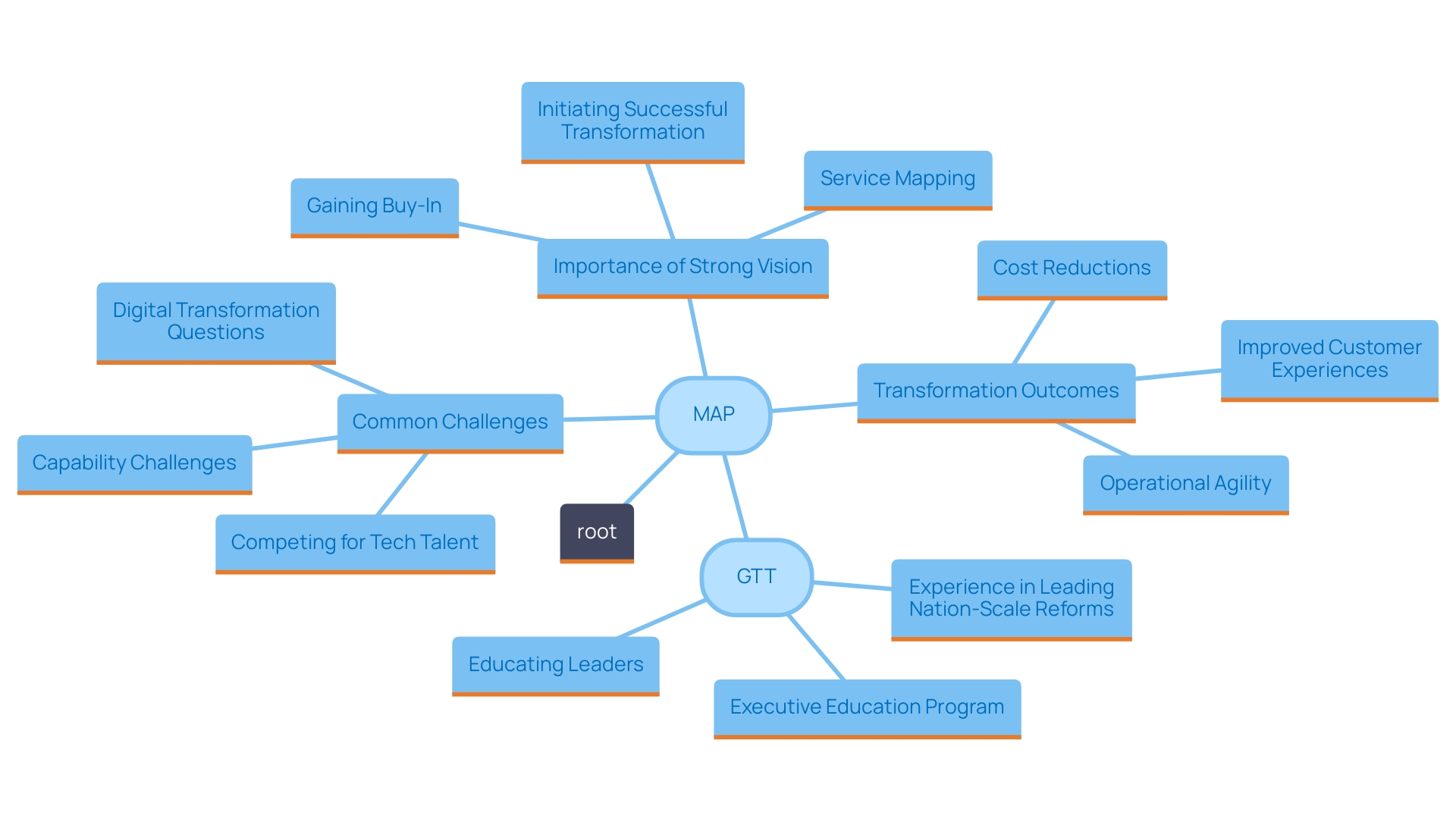
Conclusion
The AWS Migration Acceleration Program (MAP) presents a robust framework for organizations aiming to transition to the cloud efficiently while achieving significant operational benefits. By emphasizing structured phases—Assess, Mobilize, and Migrate—MAP guides businesses through the complexities of cloud adoption, ensuring they are well-prepared and strategically aligned throughout the process. The program's focus on expertise sharing and collaboration with AWS partners further enhances the likelihood of successful migrations, allowing organizations to leverage best practices and resources tailored to their unique needs.
As digital sovereignty becomes increasingly vital, particularly in regions like Europe, AWS's local infrastructure offers organizations the competitive edge required to thrive in a rapidly evolving landscape. The financial incentives and funding options provided by MAP serve as critical enablers, helping organizations cover essential aspects of their migration journey. Furthermore, adherence to best practices—such as establishing clear objectives, fostering open communication, and implementing change management strategies—ensures a seamless transition while maximizing the benefits of cloud technologies.
Real-world case studies underscore the transformative potential of AWS MAP, illustrating how organizations across various sectors have achieved remarkable outcomes through strategic cloud migration. By harnessing the power of cloud technologies, businesses not only enhance their operational capabilities but also position themselves as leaders in their respective fields. As organizations consider their cloud migration strategies, embracing the AWS MAP framework can significantly increase their prospects for success and innovation in a digital-first world.




